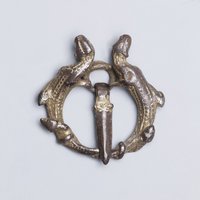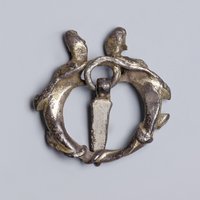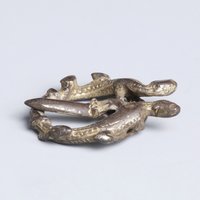Norman buckle brooch
A very unusual, silver-gilt, Norman, annular brooch. The ring is formed as a pair of lizards or wyverns with their tails wrapped around the shanks, and with their heads raised. The pin to the centre resembles a sword.
Date: Circa 12th century AD (late 12th - mid-13th-century).
Provenance: Formerly the property of Lord McAlpine, acquired from M Braham in the 1980s.
Condition: Very fine, with some signs of ageing on the surface.
During the Medieval period, the wearing of brooch was very fashionable, with the buckle pinned at the neck as a fastener. Brooches of annular form were used by both men and women from the 12th century onwards, and became extremely popular during the 13th and 14th centuries. Usually they were made of bronze or silver, and in some cases in gold. This brooch displays the fine Norman Romanesque work of this period: Norman visual art shares features similar to those of the cultures they conquered, as is seen in metalwork, stonework, and religious artefacts.
Romanesque art began to appear in Europe around 1000 AD, not giving way to the Gothic style until the 12th – 14th century (though this depends on the region). The styles and techniques used in the Romanesque period are similar to those of the Byzantine Empire. Objects of important practical use, such as signet rings and belt buckles, were turned into fine jewellery, with buckles being made from precious metal and decorated with precious stones and pearls.
The precise symbolic meaning of a lizard differs depending on the culture. In ancient Rome, the lizard was representative of death and rebirth, since it was believed to go into hibernation for the winter, and to reappear again in spring.
Despite adopting the Romanesque style, animal ornamentation remained a strong theme of Norman metalwork, reflecting their Viking pagan past. Ultimately though, animal ornamentation also reflected Christian symbolism, telling of a world view where man's place in nature was part of a greater unity, created by God. I think this formulation is exactly spot on, addressing why I am also fascinated by this - relatively shortly lived - era where these style of artefacts were made.
Robert Webley added:
'I suppose, in England, 'Norman' is perceived more as a political, or sometimes chronological, term, rather than a cultural one (though it is more likely to be used by architectural historians). It would be more likely to refer objects of this period by the general term 'medieval', or in other chronological terms (e.g. 12th century)'.
Weighing only 1.89 gram and measuring only 18 mm width and 19 mm length one might wonder how and where it was worn, in all its fragility and seemingly limited possibility holding (on) a dress part.
Well. I could have been with these stones until after dark, but as my wife wanted to travel on.. well.. I see you again, some day, hogback stones from Gosforth. And if you happen to be there one day, do not forget that monument on the outside...
Further on with the Cumbrian hogbacktour !
In - yes, luckily again in - St. Peter's church in Heysham, there is a truly beautiful hogback stone. The guide told us, it had been studyied by Thor Ewing, a writer, in 2000. in 'Understanding the Heysham hogback' A tenth century sculpted stone monument and its context (link), Thor Ewing tells in detail what he dicovered on the both sides of this hogback stone.
Just being brought in the church as late as the 1970's accompanied with some protest here and there among the church visitors, considered as being a token of old paganism, it had been remarkably nice preserved, and a lot of detail can be seen, still. Truly worthwile a visit.
I had a small debate with the guide in the church if the - zoomorphic, in my opinion - faces on the sides were lions (or hippo's). The guide doubted if the vikings could have known about lions. Well I guess so, concerning the runes on the Ancient Greek lion statue at the Arsenal, Venice. For example. Vikings did travel south..
But when he told me he was doubting the vikings 'discovered' (as the native inhabitants were of course, in the first place) America before Columbus, I decided to rest my case..
One has to know when to start and to end a conversation ..
Just discovered the book in a bookstore written by Geoff Holder - The guide to the mysterious Lake District, I knew there had to be another hogback stone in Lowther, St. Micheal's Church. With a promising image described in the text of 'a naval and a land-based force of shield-bearing vikings above a fish and what might be a coiled sea serpent. On the reverse is a row of female figures with snakes, possibly a representation of the hideous hag Hel'. Wow. If that did not sound as a true pagan promised land ..
Not complaing too much after all we have seen, this visit was the dissapointing one of them all. But if you wife states 'I am happy to have seen them' and I am answering 'Measuring is knowing' and the even more obligate verb 'handling 'if we did not see it at all, we wouldn't have known anything at all of how they were looking' the glass was again half full, at the last day of our journey..
The hogback stone appeared to be just being tolerated within the entrance segment part of the church. As something you never use anymore but you do not throw away - entirely. That sort of feeling emerged when seeing this hogback asylum seekers.. Bed, bath and bread, ás we say in Dutch, but no luxury at all and standing on some outcuts of wood, you would balance the table with at home..
Come on, St. Micheal's Church.. care a bit more of your 'children' !
This hogback stone was moved in the church in 1907. Hogback stones layed partially buried in the churchyard before it was dug up and moved into the church.
The promising depiction of a longship - as certainly can be seen after some studying - see http://vikingminds.co.uk/pages/longship
we have missed !
The stone itself is (157 x 50 x 30 cm) and very worn.
The hogback stones in Cumbria - very diverse in quality, but everyone worth a visit ! Especially on a gloomy day in late October ...
The churches to visit - see photos of resp. St. Andrew's church in Penrith, St. Mary's church in Gosforth, St. Peter's church in Heysham and St. Micheal's church in Lowther.
Did I miss out on another one in Cumbria ? Let me know !
In a next blog I will take you to four - still remaining utterly mysterious- statues 'guarding' the graveyard of St. Andrew's church in Dacre..
For the last blog of October 9th see this link.
References: (as always, links to where the books can be ordered are attached).
Edwards, B.J.N. Vikings in North West England - The artifacts (1998);
Emery, Gordon, CURIOUS CUMBRIA, The Lake District & Beyond: A celebration of Cumbria (2023)
Ewing, T. 'Understanding the Heysham hogback' A tenth century sculpted stone monument and its context ;
Hall, R. Viking Age archaeology in Britain and Ireland (first printed 1990, reprinted with amendments in 1995);
Holder, G. The guide to the mysterious Lake District (2009)
possibly also (as there within the part of Cumbria dealing with Carlisle, the Eden Valley, Barrow-in-Furness, Whitehaven and the west coast is being dealed with)
Holder, G. Paranormal Cumbria (2010)
http://vikingminds.co.uk/pages/longship


